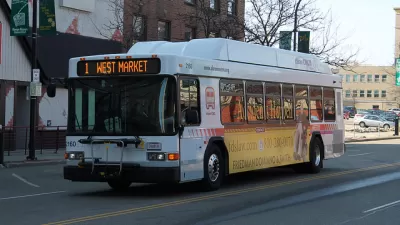Ride hailing apps have changed the way people travel. Though public transit may lose ridership to these services, transit should also learn from technological advancements and use those insights to improve transit service.

"After years of impressive increases, transit ridership tumbled by 6.3 percent last fiscal year on SEPTA and PATCO -- and that was before the Silverliner fiasco on SEPTA’s Regional Rail. Though the evidence is still circumstantial, many believe ride-hailing apps like Uber and Lyft are responsible for spiriting them away," Inga Saffron reports for the Philadelphia Inquirer. This trend is playing out in many cities around the country. Declines in ridership mean less funding for public transit and more traffic for all commuters.
Saffron argues that transit agencies like SEPTA have an opportunity to learn from their competitors by doing things like simplifying payment. SEPTA should also take declining ridership as motivation to improve service through proven best practices (like all-door boarding and removing little-used stops on bus routes) Saffron suggests.
FULL STORY: Ride-hailing apps are killing taxis. Is public transit next?

Alabama: Trump Terminates Settlements for Black Communities Harmed By Raw Sewage
Trump deemed the landmark civil rights agreement “illegal DEI and environmental justice policy.”

Study: Maui’s Plan to Convert Vacation Rentals to Long-Term Housing Could Cause Nearly $1 Billion Economic Loss
The plan would reduce visitor accommodation by 25% resulting in 1,900 jobs lost.

Why Should We Subsidize Public Transportation?
Many public transit agencies face financial stress due to rising costs, declining fare revenue, and declining subsidies. Transit advocates must provide a strong business case for increasing public transit funding.

Paris Bike Boom Leads to Steep Drop in Air Pollution
The French city’s air quality has improved dramatically in the past 20 years, coinciding with a growth in cycling.

Why Housing Costs More to Build in California Than in Texas
Hard costs like labor and materials combined with ‘soft’ costs such as permitting make building in the San Francisco Bay Area almost three times as costly as in Texas cities.

San Diego County Sees a Rise in Urban Coyotes
San Diego County experiences a rise in urban coyotes, as sightings become prevalent throughout its urban neighbourhoods and surrounding areas.
Urban Design for Planners 1: Software Tools
This six-course series explores essential urban design concepts using open source software and equips planners with the tools they need to participate fully in the urban design process.
Planning for Universal Design
Learn the tools for implementing Universal Design in planning regulations.
Smith Gee Studio
Alamo Area Metropolitan Planning Organization
City of Santa Clarita
Institute for Housing and Urban Development Studies (IHS)
City of Grandview
Harvard GSD Executive Education
Toledo-Lucas County Plan Commissions
Salt Lake City
NYU Wagner Graduate School of Public Service





























